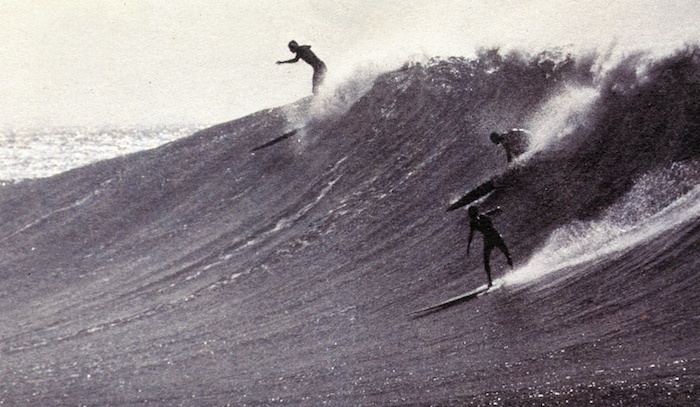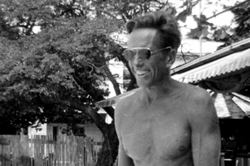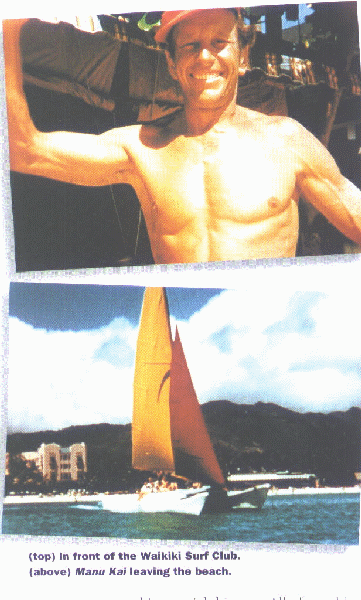Name Woody Brown | Role Surfer | |
 | ||
Died April 16, 2008, Honolulu, Hawaii, United States | ||
Woodbridge "Woody" Parker Brown (1912–2008) was an American surfer and watercraft designer best known for inventing the modern catamaran. He was also instrumental in promoting the growth of surfing in the mainland United States; among his accomplishment in surfboard shaping was an early fin design.
Contents
- Early life
- Aviation
- Surfing
- Death WWII and more surfing
- Modern ocean going catamaran
- Later life
- References

Early life

Woodbridge Brown was born into a wealthy family of Wall Street brokers on January 5, 1912 in New York City. By the time of the Wall Street crash of 1929 he had rejected the trappings of this life, though still benefited from its connections. At this time, he had moved out of the family home and was sleeping on hangar floors, helping with chores with early aviators such as Charles Lindbergh, whom he waved off on his historic 1927 flight to Paris.
Aviation

Inspired by Lindbergh, he bought a glider for $25 and towed it to California with his new four-year-old stepdaughter Jenny and wife Betty Sellon, a widowed daughter of a retired army officer with a distaste for the glitz of the "gilded age", whom he'd met at a society party he'd been persuaded to attend. For the next 5 years he was an active member of a small group of pioneering gliders. He survived some spectacular crashes.

Brown was the first to launch a glider off the cliffs at La Jolla and in 1939 set a new world record for altitude, distance, and time aloft by flying his glider, Thunderbird, 263 miles from Texas to Kansas. He received a telegram of congratulations from President Herbert Hoover.
Surfing
Brown began body-surfing in California on a carved wooden plank, using it in a style now known as Boogie-boarding. Realising that if he could stand up he could catch waves before they broke, he used glider construction techniques to build his first hollow plywood surfboard in 1936, a forerunner of modern boards.
For more maneuverability, he added a skeg, or small keel, a breakthrough independently developed by another legendary American surfer, Tom Blake, a year or two earlier. Brown was happy to give Blake credit:
Death, WWII, and more surfing
His wife Betty died giving birth to a son, Jeffrey, in 1940. Brown suffered a breakdown: "She was all I lived for. I cracked up." Depressed and near-suicidal, he left the baby Jeffrey and stepdaughter Jenny with Betty's family and moved to Hawaii, not making contact again until they were grown up due to his remorse and guilt.
He had intended to move to Tahiti, but WWII's intervention prevented him getting a visa so he was forced to stay in Hawaii. Brown was a conscientious objector during the war (and had been a vegetarian since his youth after looking into the eyes of a chipmunk he had wounded with a shotgun).
He joined half a dozen other surfers who collectively became known as the Hot Curl surfers, named after a new type of board they carved, semi-hollow, with a V-tail to avoid what they called "slide-ass" and help them stick to the "hot curl", the breaking curve of a wave.
Brown was one of Hawaii's first big wave surfers and board designers. He was nicknamed "Spider" because, as he put it, "I surf with my arms all out, half squatting down, and with my long legs I look like a big spider riding a board." He was captured in a 1953 photograph by Thomas Tsuzuki which helped turn Hawaii into a mecca for surfers worldwide. It showed three men riding a 20-foot wave, the kind rarely if ever photographed close-up in those days. Brown was the only one who "made" the wave.
A surfing spot in Lahaina is nicknamed after him. As recalled by Drew Kampion, surf historian of Washington state and former "Surfing" magazine editor:
Modern ocean-going catamaran
After the war, Brown served as a United States government surveyor on Christmas Island. There he was fascinated by the speed of the Polynesian natives' twin-hulled outrigger canoes. Upon his return to Hawaii he adapted the idea, using lightweight hulls and adding huge sails. In 1947 he designed the Manu Kai ("Sea Bird"), which was built by the Hawaiian Alfred Kumalai,and Rudy Choy. It was probably the fastest sailing boat in the world at the time and now seen as the first modern, ocean-going catamaran.
Later life
Brown, having benefited from the Hawaiians' aloha spirit of generosity when he first arrived, became the epitome of that spirit in later life and was renowned for sharing "life's positive energy" with whomever he met.
He met and married his second wife, Rachel, a hula dancer, in the mid-1940s, and had two children with her: William and Mary-Sue. Rachel died in 1986 and the following year, "feeling lonesome", he married Macrene Canaveral, whom he met in the Philippines on a trip specifically "to get me a new wife". Their son, Woody Jr., was born when Brown was 76.
Brown never sought fame or recognition. Nevertheless, he featured in two U.S. documentaries, Surfing for Life (1999) and Of Wind and Waves: the Life of Woody Brown (2006), both made by the mainland American David L. Brown (no relation). It was during the filming of the latter that he was reunited with Jeffrey and Jenny.
Brown died on April 16, 2008 at Hale Makua, Kahului.
